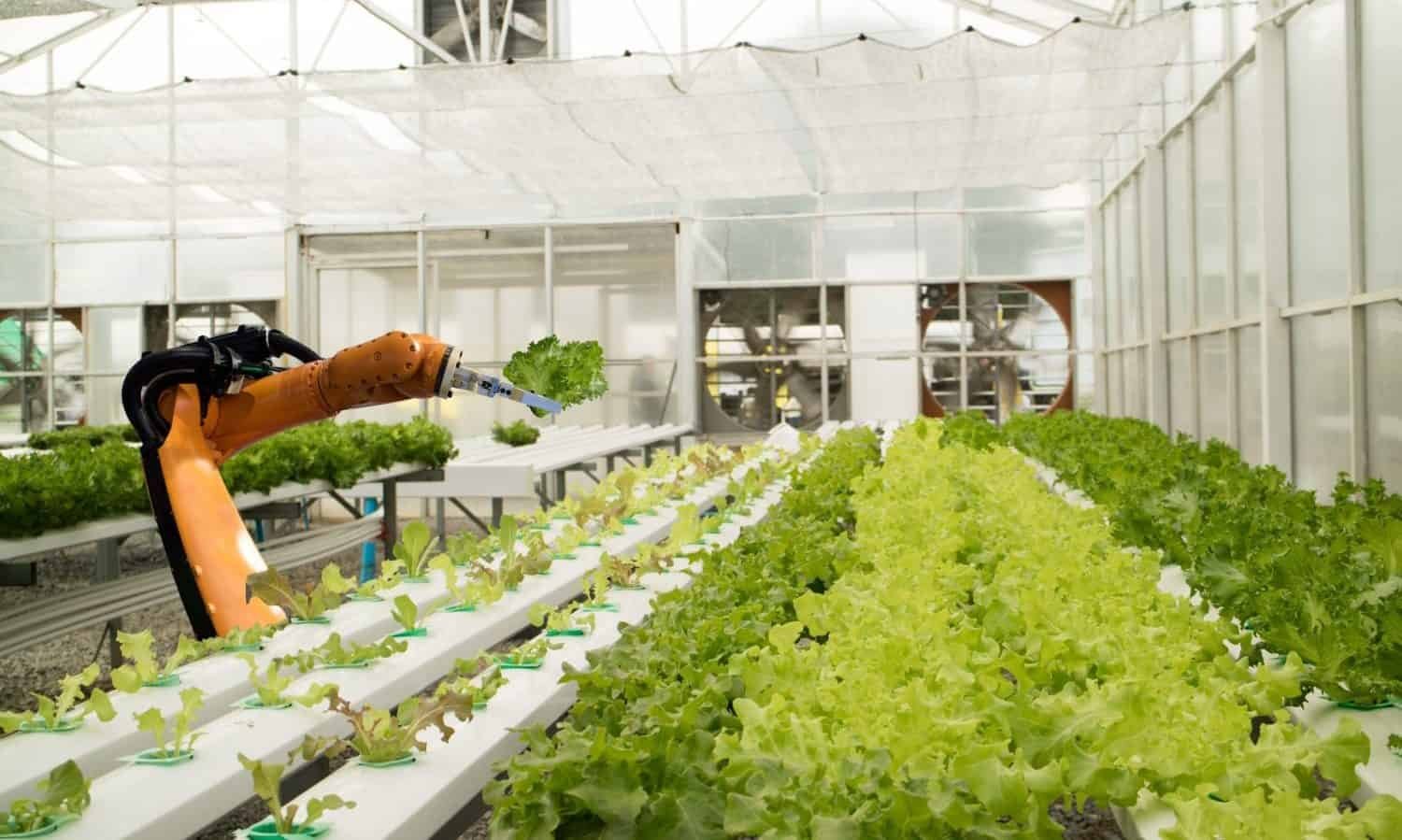From planting seeds to stocking grocery shelves, artificial intelligence (AI) is revolutionizing how we produce food. While AI may seem worlds away from traditional agriculture, this powerful technology is quickly becoming an essential tool across the farm-to-table journey.
By combining Artificial Intelligence capabilities like machine learning, computer vision, and robotics, the agriculture and food industries are increasing efficiency, reducing waste, and implementing more sustainable practices. And as global food demands continue rising with population growth, AI will play a pivotal role in helping our food systems keep up.
Want to understand how Artificial Intelligence is transforming agriculture and food production? Keep reading to explore the innovative artificial intelligence solutions taking root!
Contents
Precision Agriculture with AI
Predicting Optimal Grow Conditions
Through machine learning and predictive analytics, Artificial Intelligence models can analyze a dizzying array of data points like weather forecasts, soil conditions, pest risks, and historical records. This deep data crunching allows Artificial Intelligence to pinpoint the optimal planting times, water usage, fertilizer needs, and other factors for maximizing crop yields and quality.
artificial intelligence-powered services deliver these precise recommendations directly to farmers’ mobile apps, automating and fine-tuning the decision-making process. Not only do these insights boost productivity, they also cut costs by minimizing resource usage and preventing losses from poor planning.

Monitoring Crop Health
What if your crops could “talk” and tell you exactly what they need? Advanced computer vision artificial intelligence makes this possible. By studying aerial and ground imagery captured by drones or field cameras, artificial intelligence models can detect emerging issues like nutrientdeficiencies, pest infestations, or disease with incredible accuracy at an early stage.
Artificial intelligence vision systems leverage specialized models trained on massive datasets of plant images to visually monitor every crop in the field simultaneously. Farmers can then receive automatic alerts and detailed analytics on their mobile devices to quickly address any areas needing attention or treatment. This 24/7 health monitoring leads to higher yields and reduced croploss.
AI Robotics in the Field and Beyond
While artificial intelligence monitors for crop issues, smart robotic systems enabled by artificial intelligence can precisely apply just the right interventions like pesticides, herbicides, water, or nutrients exactly where needed. This precision spraying and targeted application radically cuts chemical and resource usage compared to conventional blanket spraying methods.
Artificial intelligence is also enhancing mechanical harvesters, enabling them to operate autonomously based on machine vision. These self-driving robotic harvesters can work around the clock, optimizing harvesting schedules and efficiency while reducing labor costs.
After the harvest, artificial intelligence systems at packaging and processing facilities automate sortation and grading of crops using advanced imaging and modeling techniques. artificial intelligence vision can assess subtle factors like color, size, ripeness, defects, and more with superhuman consistency and accuracy. Only the highest quality produce moves on to market.
Optimizing the Food Supply Chain
AI continues providing major value downstream in the complex global food supply chain. Smart sensors and cameras powered by computer vision artificial intelligence monitor every stage, from truck transport to warehousing, to detect signs of temperature issues, bruising, spoilage, or other factors that could impact freshness, quality, and safety.
At retail stores and distribution centers, artificial intelligence-driven inventory management optimizes stock levels, predicts demand fluctuations, reduces waste from overstock, and streamlines ordering of new supplies. And tools like the artificial intelligence “greenwave” even use predictive modeling to route fresh produce shipments as efficiently as possible for maximum shelf life.
In processing facilities, machine learning algorithms rapidly inspect food products from incoming raw materials to packaged goods, rejecting any substandard or contaminated items before reaching consumers. This rigorous automated inspection provides a major food safety boost.
A Sustainable Future for Food
Beyond boosting productivity and quality, another key way artificial intelligence is transforming agriculture and food production is through more sustainable practices. The precision farming methods enabled by AI dramatically reduce water usage, pesticide/herbicide spraying, fertilizer needs, food loss, and overall environmental impact.
artificial intelligence-powered farm management also helps maximize resource efficiency and lower emission levels through optimized processes, smart equipment monitoring, and data-driven decision making. Machine learning models can even help identify new crop varieties optimized for specific conditions to boost climate resilience.
On the consumer side, artificial intelligence recommendation engines are emerging that can suggest recipes and meal plans tailored to individual preferences while minimizing food waste. By only purchasing what we need based on artificial intelligence’s demand forecasting, we can collectively curb the staggering amount of food that gets thrown out from homes.
The agriculture technology (agri-tech) field leveraging artificial intelligence and machine learning has exploded in recent years as the world searches for smarter farming solutions. With over $7 billion in funding annually, agri-tech startups are rapidly developing innovations to increase food production in sustainable ways.
The Future of AI Farming
While many sophisticated artificial intelligence systems are already being deployed, we’ve really just scratched the surface for AI’s potential in agriculture and food. Here are a few exciting areas that could shape the future:
- Autonomous farm operations handled end-to-end by fleets of intelligent robots and drones for planting,monitoring, maintenance, and harvesting with little human intervention.
- Highly advanced artificial intelligence greenhouses and vertical farms optimized for year-round food production in any climate or environment, even in inhospitable regions or space.
- artificial intelligence-designed advanced seeds and crops engineered for specific traits like higher yield, drought resistance,improved nutritional value, and more.
- Blockchain and artificial intelligence-driven supply chains providing radical transparency from farm to fork about a food product’s full origin story and journey.
- In-home artificial intelligence assistants that automatically manage food planning, shopping, preparation, and minimizing waste tailored to your household.
As artificial intelligence capabilities in areas like machine learning, robotics, computer vision, sensor technology, and synthetic biology continue advancing, the agriculture and food production industries will experience even more technological transformation in the decades ahead.
Reaping the Benefits of AI-Driven Agriculture
There’s no denying that artificial intelligence is rapidly becoming an indispensable tool across the agriculture and food production pipeline. With rising food demands, climate change concerns, and environmental pressures, we need sophisticated solutions for meeting these challenges sustainably.
Artificial intelligence provides that technology-driven edge by enabling precision farming, automated processes, predictive analytics, and data-driven resource optimization. Not only does this boost productivity and operations, but AI-powered agriculture leads to farming methods with a lighter environmental footprint long-term.
While not all solutions are ready today, the agriculture industry should start acclimating to the artificial intelligence-driven future. Those who embrace this agri-tech revolution and invest in artificial intelligence capabilities will reap a bushel of benefits over the long haul.




